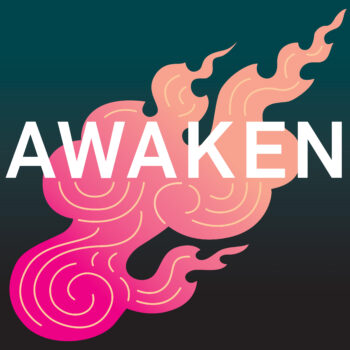
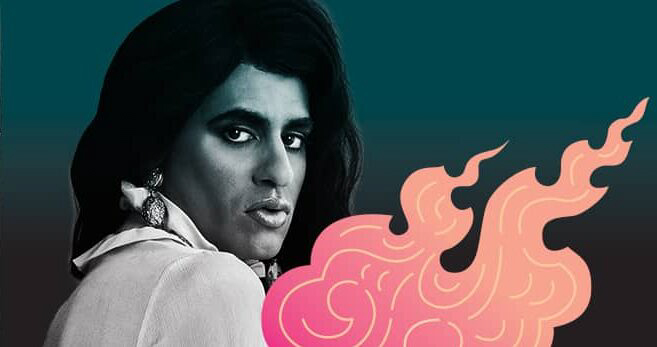
What if enlightenment is not something to strive for, but an innate quality born to every human being? Gender non-conforming writer, performer, and public speaker Alok Vaid-Menon challenges us to see the divine nature in every person, including ourselves, and asks who we might be if we choose to step outside of the limitations of judgment.
ALOK VAID-MENON:
I sacrificed so much. That sense of safety, of trust, of legibility and coherence. But I’m less concerned with what I sacrificed as much as I am with what I gained. And what I gained was my life back.
LAURIE ANDERSON:
Welcome to AWAKEN, a podcast presented by the Rubin Museum of Art in New York City. That was the voice of Alok Vaid-Menon. And I am your host, Laurie Anderson.
In this 10-part series, we explore the dynamic path to enlightenment and what it means to wake up. We’ll hear from authors, artists, wisdom bearers, and Buddhist teachers, people who have experienced a shift in their perspectives on life throughout their personal journey. This podcast is inspired by the exhibition Awaken: A Tibetan Buddhist Journey Toward Enlightenment, which illustrates the stages of enlightenment through paintings, sculptures, and other objects. We use these artworks as a jumping off point to better understand the paths our guests have been on and where they are going.
Buddha taught that suffering is part of the human experience, but he also taught that there’s a way out. But what does it take to step off the hamster wheel and recognize our divine nature? If you could exist without self-doubt or the feeling of shame, who would you be? For many, the path to enlightenment begins by acknowledging suffering but not letting it define who we are.
In this episode, we examine our divine nature and consider who we truly can be in the absence of judgment. We speak with internationally acclaimed, gender non-conforming writer, performer, and public speaker Alok Vaid-Menon, whose work speaks to themes of trauma, belonging, and the human condition. They share with us their spirituality, poetry, and what it means to live beyond the gender binary.
But before we begin, Alok first shares their thoughts of a sculpture titled The Buddha Triumphing Over Mara. In this sculpture, the Buddha’s right hand is depicted touching the ground as he calls the earth to witness his triumph over the demon Mara. Mara is often described as representing the inner forces of illusion and ignorance. When he overcame these forces, the Buddha was able to achieve enlightenment. To use his own words, he once declared, “I am not a man. I am awake.”
ALOK VAID-MENON:
I see peace and serenity and surrender and acceptance of what is. I see interconnectivity with nature, the earth, humanity, and a deep practice of humility. That idea of the only witness necessary being the earth I think is really powerful to me, because I think that so much of what the dilemma of humanity is that we’re constantly trying to prove what already is. And what I really appreciate about the story is it requires us to kind of move out, zone out, zoom out of just like an interpersonal interaction and see the world from a different perspective, and be like, what, from the perspective of a tree or from the wind, is this conflict? It’s irrelevant. There’s such a natural template for another way to relate to the earth.
I really believe in the divinity of all of us, that we are souls first, bodies second. I was raised Hindu, and I associated religion with organized religion, with a set of parameters and protocols and scriptures that had to be followed explicitly. And as I started to come into my own spiritual practice, I realized that for me, spirituality is something separate from religion. It’s the reason why I do the work that I do. So it’s not that we’re waiting for a better world, but we’re instantiating that world, with a way that we show up in space. And that feels like a spiritual practice. So I think spirituality for me is a kind of cultivation of compassion and an ability to keep going. An insistence on radiant beauty, despite all of the vapidity and the vehement violence.
The work of soul searching came to me through being an artist. I feel like every day is an artistic and spiritual endeavor to be what is. What am I feeling in this moment? How do I express it? The poem is no longer just a thing that I’m writing, but actually the way that I’m living, how I walk down the street, what I see, what I notice, how I speak to other people, how I treat and think of other people, how I engage with one another. That is the poetic work. I think for me it also takes the form of style. I describe putting together an outfit as making an altar on my body.
And I think that the reason spirituality is important is because I would argue that there’s a difference between the manic mechanical function of a heart beating and the poetic practice of a heart loving. And that dissonance, I think, is the crisis of our times. That while we might mechanically be alive, while we might be speaking, we never really do the due diligence to ask, Are these the words of my own that I’m speaking? Are these my own feet? Are these my own hands? Is this my own gender? Is this my own life? Is this my own beauty?
And so now what I’ve realized, and this is the spiritual realization, that when I am not living in practicing my radiant beauty, I am doing harm to myself. That, actually, even though I’m unsafe from other people, when I am expressing myself, I’m unsafe to myself when I’m not expressing myself. So who am I going to prioritize?
And that’s, I think, where the spirituality comes in. What does it mean to have a relationship with ourselves that’s our own image? To have relationship with our beauty that’s our own beauty? To have a relationship with our body that’s our own body? And what does it mean to move from there? And so, what I guess I’m trying to cultivate in my life is the kind of courage and conviction and stamina to continue every day to ask myself, Who am I? And then practice that. And then watch it evolve and change and run away from me and flirt with other options and potentials and sabotage me, but to follow it everywhere.
I think that I always want to remember and teach the world that I was born with a heart, two lungs, two eyes, no shame. I didn’t have shame. So my organic predisposition was actually one of radical self-acceptance. No need to encapsulate my universes into frameworks of gender. I just was.
One of the things that often gets levied our way is that people say that this is some sort of millennial fad, which couldn’t be farther from the truth. We have deep ancestral roots and evidence of thousands of years of people, not just existing, but thriving and being celebrated outside of the Western division of populations into man/woman, male/female. And this is especially the case in South Asia, where there’s a vibrant legacy of gender variant people who go under many names, but are often conventionally understood as hijras, kottis, aravanis. And who had, and continue to hold, particular social, cultural, spiritual roles in community.
And what most people don’t know is that one of the tactics of colonization was the attempted cultural genocide of these populations. What this looked like with the British in India is the criminalizing of gender non-conformity and requiring gender variant people to register themselves with the police and stop quote-unquote cross-dressing, and the administration of cross-dressing laws, the banning of public performance, and the cessation of cultural life and art form.
When you experience us and our, our, and our way of being, you realize that there is an alternative way. There’s, in fact, a third way. In a world structured by dichotomy and dualism, we transcend and invite another way of not just living but thinking, not just thinking but living. And that can’t coexist with a project that is more about control than creative self-exploration. So the goal has always been about elimination of us. And that’s what we’re seeing, unfortunately, in 2021. Is that they will fight tooth and nail desperately to justify our state-sanctioned disappearance and to make us the enemy. When in fact we are guilty of the crime of being alive and meaning it.
I think there’s a reason when I research in my own work the long legacy of gender variant people across the world and many cultures, that we were associated, so often, with medicine people or healers or divine leaders, because we understood that in so many ways, we were preparing the body to receive higher wisdom. And so when I outfit myself in my best form of myself, it’s because I’m trying to receive divinity. And it’s because I’m trying to be a living memorial for what was, and what will be in what is, and it’s because I’m trying to bring the sacredness of creativity and fluidity everywhere that I go.
I used to love dancing, and I think dance was my first language. Because before I could speak, I could gesture. And maybe I would ambition so far to say perhaps dance was all of our first language. And so actually I had a relationship with my body that I am still trying to remember, which was, I just moved to communicate. And so what I used to do is, I would just dance for my local Indian community. I’d put on an old Bollywood track and I would just dance.
It felt like I didn’t have a body anymore. It felt like the body was a mere suggestion. Like I was interconnected with everything: the air, the people around me, the music. It was one and the same. I guess the academic in me would say, I felt like I was no longer a subject. I was no longer an individual. I was feeling and being. I was dematerialized and less concerned with form than I was with flow.
What I recollect is a feeling of unbridled joy, a feeling of wonder, of the enormity and potentiality of my body and this universe and art. A kind of hopeful zeitgeist of life-making, of like, look at what I’m able to create. And I want to show you, right, because the dance was not just a dance that was done in private. It was a dance that I wanted to stage for my own community. It was a dance that I later staged at my school talent show, for better or for worse. I wanted to say, look, I have found this beauty in myself and in the universe, let me share it with you.
And I wanted so badly back then to be a dancer. I would tell everyone, I’m going to grow up and I’m going to be a dancer. And then people began to tell me that the way that I moved my body was wrong, because it was feminine. And because I was a quote-unquote boy I was not supposed to be that feminine. And so I think I lost that fluidity. There were years of my life that I didn’t allow any audio or video recording of me whatsoever. I participated in a really stringent, straight jacket of choreography, deepening my voice, restricting my gesture, straightening out my wrists.
I don’t know if I’ll ever be able to account for the grief of it, but I think that what I can do and what I hope to do is to believe that healing is possible. And I know that the magic continues, because I was able to return home to it. And I can feel it there in my voice. And I can feel it there in the way that I move. And that kind of sense of recognition and that sense of self-acceptance and that sense of surrender to the kind of quiet pulse of the earth having a heartbeat is what I would describe why we do this thing. You know, I think that there’s a lot of misapprehension, miscomprehension about people like me. Why would you do this, if it exposed you to more harm and scrutiny? Why would you do this, if you lost access to power, legitimacy, intelligibility? To which I would ask, why wouldn’t you do this? Why wouldn’t you live in the pulse of the universe? Why wouldn’t you accept your own vibrancy and fluidity? Because that’s the substance of life itself.
I sacrificed so much. That sense of safety, of trust, of legibility and coherence. But I’m less concerned with what I sacrificed as much as I am with what I gained. And what I gained was my life back. Was not just self-actualization but a self. And in so many ways, the enduring forms of harassment that I experience are the universe asking me this question over and over again. Are you willing to go back? Are you willing to go back to living someone else’s lie? And at least for now I say no. Because there are things more important to me than that. And I’d rather spend my life and my career speaking about those important things. I think that when it comes to trans people, the narrative right now is so obsessed with us and a collateral damage of existing and having in the world as a trans person, like, woe are them. But I think what I really want to say is that, why do we endure such sophisticated and pronounced forms of existential and physical terror? Could it be that we actually are practicing something that’s so important and organic and necessary that it’s more important than that?
There’s so many turning points. The feeling I get in me is that we have been so structured by the logics of cinema that have made us feel like there has to be this kind of transcendental moment of realization. But I don’t know if that’s honest about being alive. Because the thing is, you have revelations about yourself, but you’re not ready yet to live those revelations. And so you default back into your self-sabotaging coping strategies, and then two months later, something falls apart and you’re like, oh, I’ve been meaning to address this and I never did. And it’s just idiosyncratic and strange and utterly uncinematic. And I think I love movies, but I love being alive more. And so freedom for me is a daily practice, and it’s constantly evolving and absolutely not linear, which is so unfortunate sometimes. But I think once I started to experience the delight of freedom, there was no going back. And I really want to say that art was that for me. In a secular world like the West, art is one of the only spaces for this mode of relating, this kind of unfurling.
So it was summer 2012 in Cape Town, South Africa. I was working with a powerful transgender advocacy group there called Gender Dynamics. And I caught fire, which is intense. Basically, there was a space heater that I didn’t turn off, that my mattress got embroiled with. And I woke up in flames. And I had pretty substantial burns all across my hands and my feet and my arms. And I had to basically stay at home and I started to really write.
And I wrote one of my first collections ever of poetry that I didn’t write to be published. Then I convened a group of us at the end of that summer and I recited it to them. And I remember speaking it and being like, whoa, this is what I, not just what I want to do for the rest of my life, but this is what I am. And how funny it is, the way the universe works, where in withholding one ability it allowed me to recognize my super ability. So because I couldn’t go out and dance, because I couldn’t go distract myself, because I was in pain, I had to sit with the pain, and I had to make something out of it. And I had to alchemize it and hack at it. And I realized that pain can’t be eternal, because I can still make beauty from it. That’s not to say that it’s not still painful and awful and bad, and it’s not to romanticize, but it is to say that nothing is fixed. And the alchemic work of rematerializing what was into what could be is the work of being alive, I think.
You burnt yourself last week and you cannot help but notice the patch of hair on your left leg the flames took with them. Cannot help but smile when your nurse shaves your right thigh for your bandage. These are the sacrifices a body must make for growing too fast. And sometimes you wonder if you caused the fire. And sometimes you wonder if you should have kept shaving and the hair keeps coming back and the wounds keep throbbing and the man inside keeps knocking and you, who are impatient, keeps running. And I have never been good at waiting. But I am seeing the ways that my fingers are phoenixes, becoming touch again. With every tear I am seeing the miracle of body. The way hair grows back, scabs heal, lips kiss.
There’s this term that’s circulating called chromophobia, fear of color. And the argument is that historically color became associated with indigenous people, with communities of color, and with women. And so then color became associated with anti-reason, emotion, unrestraint, unbridled ways of being. And so much of the formalization and consolidation of European-Western modernity was also a project of aesthetics and color. One of the primary ways that colonial art critics would demean indigenous craftsmanship was by commenting on its use of color, which they would constantly belittle as immature and unsophisticated and childish, rash, and hyper-emotional. And so the connotations that we inherit of color are that color is something that should be feared or something that should be relegated to the special event. That color brings too much attention to yourself, that you should try to tone it down to fit into the visual cues of the dominant world.
But color was one of the first realms of resistance I had. Color became language. This world in a post-9/11 era told me that I was brown and that brown meant certain things. And so then I put this brown body in a pink shirt, and what did that do? And I began to use color to communicate, there’s something else going on here. I began to use color to return to my own color and to see the large swath of colors in the world and realize it’s not that color is the problem. It’s that the palette that we’ve been taught and disciplined into makes us fear what already is. The fear is not of what could be, or what was, it’s the fear of what is. It’s the willful unnoticing. It’s the inability to see that vibrancy, diversity, instability, collapse, rupture, serendipity are the natural orientations of being alive. So color is part of that.
One of my favorite things was going to weddings and seeing intergenerational dancing. Like that feels like the real treat of the wedding. Like I’m going to let a couple finish, but it’s the after-party for me. Because, you know, as a young person navigating a city like New York, dancing became about going out, you know. It became about being seen in a different way. But what I like about a wedding dance party is everyone is just being gnarly and foolish and playful. And you see someone who you never thought dance, could dance””an 85-year-old, just with this kind of unbridled sense of possibility in every step and gesture. And then everyone loves it and they’re clapping. And it’s just a model for me of what I want the world to be””that. I’m going to act like a fool because it makes me feel good. And then you acting like a fool, that gives me permission to be a fool. And what a delight and what a joy it is to be foolish together.
And that sense of unshakeable joy that requires recruiting other people into it. There’s a conviction in it. Like, I’ve experienced this goodness, this rightness, this alignment, this beauty, why would I not want other people to be part of it? Let me share that. And I think that I still practice that commitment for better or for worse. When I see things that I love, when I learn new things, when I read new books, when I encounter new ideas, I want to share it with everyone in the world.
What a joy it is to be able to curate the sounds of my own soundtrack. When I play music, it’s not just that I’m playing music, it’s that I’m setting the scene to be alive. And that degree of intention, I hope to bring into everything. What kind of person do I want to be? Yes, but what kind of beauty do I want to make? What kind of joy do I want to cultivate? What kind of energy do I want to be a part of?
LAURIE ANDERSON:
Before we come to a close, Alok shares their practice of how breath can be used as a tool to move through moments of discomfort.
ALOK VAID-MENON:
I think that’s so often people’s imagination of what beauty is what we look like. But for me, beauty is what we feel like. I feel beauty right now in being a disembodied voice. Every time I’m feeling shame, I breathe into that location. So if it’s like, oh, I’m feeling shame that there’s hair on my face, I close my eyes and I breathe in to that. And I ask myself, is this me, or is this someone else? Is this me? Or is this someone else? And then I ask it until I can remember that the shame was not my own.
LAURIE ANDERSON:
Special thanks to Alok Vaid-Menon for sharing their experience with us. We hope you enjoyed it.
For more information about our guest and to see images of the artwork in this episode, visit RubinMuseum.org/awakenpod. If you’re hungry to continue the conversation, join us on Instagram at @RubinMuseum. And if you’re enjoying this podcast, leave us a review wherever you listen to podcasts. Leaving us a review is one of the best ways to help this podcast reach more listeners like you.
AWAKEN is produced by the Rubin Museum of Art in collaboration with Sound Made Public. And I’m your host, Laurie Anderson. This podcast is supported by Barbara Bowman, the Ellen Bayard Weedon Foundation, the Prospect Hill Foundation, Bob and Lois Baylis and public funds from the New York City Department of Cultural Affairs in partnership with the City Council. Awaken is sponsored by Tricycle: The Buddhist Review, a print and digital magazine dedicated to making Buddhist teachings broadly available. Music for Awaken was created by Blue Dot Sessions, Podington Bear, Tendinite and Siddhartha Corthus.
Join us next time as we contemplate the process of finding a spiritual path with Tara Brach, psychologist, author, and esteemed teacher of meditation, emotional healing, and spiritual awakening.
You really don’t want to miss this.
For more information about our guest and to see images of the artwork in this episode, visit AWAKEN Podcast. If you’re hungry to continue the conversation, join us on Instagram at @rubinmuseum. And if you’re enjoying this podcast, leave us a review wherever you listen to podcasts. Leaving us a review is one of the best ways to help this podcast reach more listeners like you.
Awaken is produced by the Rubin Museum of Art in collaboration with Sound Made Public. And I’m your host, Laurie Anderson. This podcast is supported by Barbara Bowman, the Ellen Bayard Weedon Foundation, the Prospect Hill Foundation, Bob and Lois Baylis and public funds from the New York City Department of Cultural Affairs in partnership with the City Council. Awaken is sponsored by Tricycle: The Buddhist Review, a print and digital magazine dedicated to making Buddhist teachings broadly available. Music for Awaken was created by Blue Dot Sessions, Podington Bear, Tendinite and Siddhartha Corthus.
Alok considers a sculpture of the Buddha Triumphing Over Mara, which depicts the moment the Buddha overcame ignorance, touched the earth as his witness, and became enlightened, declaring, “I am not a man, I am awake.” Read more about the episode’s guests below.
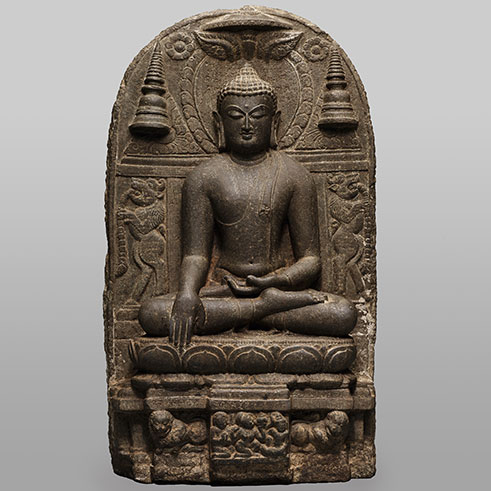
The Buddha Triumphing Over Mara; India, probably Bihar, ca. 800″“900; stone; Asian Art Museum of San Francisco; The Avery Brundage Collection, B61S7+
This stone relief shows the Buddha seated under a tree, known as the bodhi tree or the tree of enlightenment, deep in contemplation. With his right hand touching the ground he calls the earth to witness his triumph over the demon Mara, who is often described as the inner forces of illusion and ignorance that prevent the true understanding of reality.
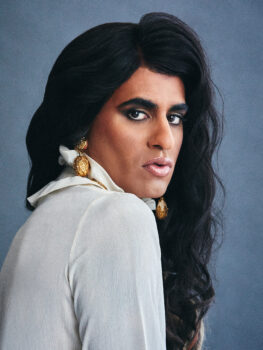
Alok Vaid-Menon (they/them) is an internationally acclaimed gender non-conforming writer, performer, and public speaker. As a mixed-media artist, Alok explores themes of trauma, belonging, and the human condition. Over the past decade they have presented at more than 500 venues in over 45 countries. They are the author of Femme in Public (2017) and Beyond the Gender Binary (2020), as well as the creator of #DeGenderFashion, a movement to degender fashion and beauty industries. Alok has been honored as one of HuffPost’s Culture Shifters, NBC’s Pride50, and Business Insider’s The Doers. They currently serve as a contributing editor to the White Review.
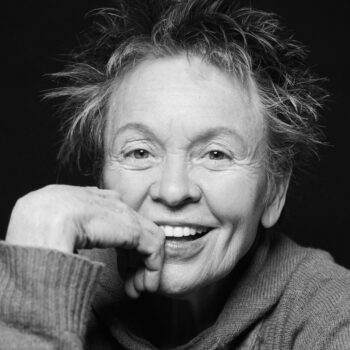
Laurie Anderson is one of America’s most renowned and daring creative pioneers. She is best known for her multimedia presentations and innovative use of technology. As writer, director, visual artist, and vocalist she has created groundbreaking works that span the worlds of art, theater, and experimental music. Ms. Anderson has published seven books, and her visual work has been presented in major museums around the world. In 2002 she was appointed the first artist-in-residence of NASA, which culminated in her 2004 touring solo performance The End of the Moon. Her film Heart of a Dog was chosen as an official selection of the 2015 Venice and Toronto Film Festivals and received a special screening at the Rubin Museum, where she joined in conversation with Darren Aronofsky. Ms. Anderson has made many appearances at the Rubin, and has been in conversation with Wim Wenders, Mark Morris, Janna Levin, Gavin Schmidt, Neil Gaiman, and Tiokasin Ghosthorse. She also hosted the premiere season of the Rubin’s AWAKEN podcast.
Get the latest news and stories from the Rubin, plus occasional information on how to support our work.